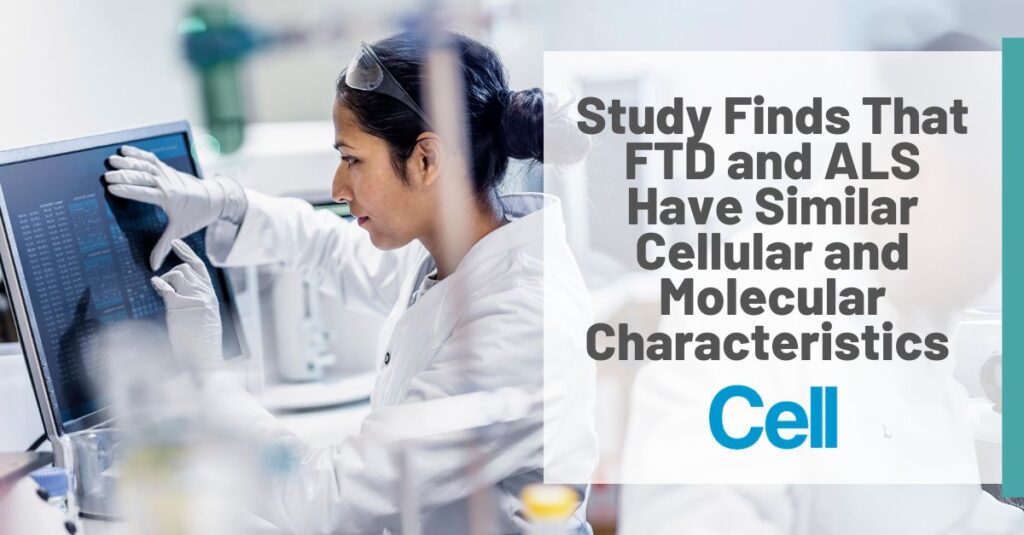Estudio revela que la DFT y la ELA tienen características celulares y moleculares similares

Un estudio realizado por investigadores del MIT y Mayo Clinic publicado en la revista Célula diario descubre que la DFT y la ELA tienen características celulares y moleculares sorprendentemente similares a pesar de sus diferencias clínicas.
El descubrimiento de 2011 de que la C9orf72 mutación genética puede causar DFT y/o ELA Los estudios han transformado la creencia, que se había mantenido durante mucho tiempo, de que los dos trastornos no estaban relacionados. Ahora se sabe que varios otros genes pueden causar ambas enfermedades y que la DFT y la ELA a veces pueden presentarse simultáneamente. Como señalan los autores, entre el 40 y el 50 % de las personas a las que se les diagnostica uno de los trastornos acaba desarrollando síntomas del otro, y hasta el 15 % de las personas que reciben un diagnóstico doble.
En el estudio, los autores plantearon la teoría de que la ELA y la DFT también compartían firmas genéticas. Aunque cada enfermedad ataca a subtipos celulares únicos en diferentes regiones del cerebro, investigaciones recientes sugieren que las neuronas afectadas de ambas enfermedades comparten marcadores moleculares. Para probar su teoría, los autores llevaron a cabo una forma específica de secuenciación de ARN para generar datos sobre la estructura molecular de las neuronas afectadas.
Similitud excepcional a nivel genético
El estudio se realizó con muestras de cerebro donadas de 73 personas. La cohorte de muestra incluía a personas a las que se les había diagnosticado DFT, ELA o que no mostraban evidencia de la enfermedad. Las muestras representaban tanto a personas cuyo diagnóstico era esporádico, es decir, que su DFT no tenía una causa genética conocida ni una conexión familiar conocida con la enfermedad neurodegenerativa, como a aquellas que habían sido afectadas por la mutación del gen C9orf72.
Según los autores, su cohorte incluía:
- 17 de donantes con ELA esporádica.
- 16 de donantes con C9orf72 ELA.
- 13 de donantes con FTD esporádica.
- 11 de donantes con C9orf72 Defecto temporal.
- 16 de donantes sin diagnóstico.
Los autores encontraron una “similitud genética excepcional” entre las neuronas afectadas por ambas enfermedades. Al examinar la expresión genética de las neuronas, el proceso mediante el cual las células convierten la información genética en productos funcionales como las proteínas, los investigadores descubrieron que las neuronas afectadas expresan genes notablemente similares. También se observó que las muestras de casos hereditarios y esporádicos de DFT y ELA mostraban cambios de expresión genética similares, lo que contrastaba con las creencias previas de que tenían causas diferentes.
“Estas similitudes fueron bastante sorprendentes, lo que sugiere que las terapias para la ELA también pueden aplicarse a la [DFT] y viceversa”, dijo a la BBC la investigadora del MIT Myriam Heiman, PhD, autora principal correspondiente del estudio. Noticias de neurociencia“Nuestro estudio puede ayudar a orientar programas terapéuticos que probablemente serían eficaces para ambas enfermedades”.
Las células vulnerables comparten patrones de expresión
Más allá de la expresión genética, los autores analizaron las neuronas más afectadas. Las neuronas de von Economo (VEN) son las células más vulnerables en la DFT, mientras que las neuronas motoras superiores (UMN) son las células más vulnerables en la ELA. A pesar de estar en diferentes lugares del cerebro, la expresión genética de los dos tipos de neuronas tenía patrones de expresión génica muy similares.
“Las neuronas UMN y las neuronas fusiformes no se parecen en nada y viven en áreas muy diferentes del cerebro”, dijo el estudiante de posgrado del MIT Sebastián Pineda, autor principal del estudio. “Fue sorprendente ver que parecen prácticamente indistinguibles a nivel molecular y responden de manera muy similar a la enfermedad”.
Los investigadores observaron una asociación entre muchos genes expresados y los cilios primarios, estructuras en la superficie de las células que detectan cambios químicos. Los autores identificaron casi 50 genes asociados a los cilios compartidos entre las dos enfermedades. Además, descubrieron que las células vulnerables expresaban genes asociados con la DFT y la ELA, lo que sugiere una posible base para la asociación genética entre las enfermedades.
Los investigadores también encontraron evidencia de disfunción cerebrovascular que complicaba la barrera hematoencefálica (BHE), un sistema de filtrado que protege al cerebro de moléculas dañinas. Se encontró que las proteínas necesarias para mantener la vasculatura cerebral estaban mal ubicadas o reducidas en la ELA. En la DFT, los autores notaron una reducción en la proteína HLA-E, que desempeña un papel en la regulación del sistema inmunológico y se cree que ayuda a proteger la BHE de la degradación por las respuestas inmunológicas.
Las muestras utilizadas en el estudio se obtuvieron después de que los donantes hubieran fallecido, lo que significa que las células cerebrales analizadas eran las supervivientes restantes. A medida que avance la investigación, los científicos podrán examinar las firmas genéticas y moleculares de las células de las personas antes de la aparición de la DFT. Estudios futuros podrían determinar si existen firmas únicas en las células que se degeneran en la DFT y la ELA que se puedan detectar de forma temprana.
Los científicos están estudiando cada vez más los vínculos entre la ELA y la DFT para encontrar nuevas formas de diagnosticar y tratar ambos trastornos. Investigadores de la Universidad de Sheffield en el Reino Unido descubrieron en un estudio publicado a principios de 2024 sobre cómo Prevenir la producción de proteínas tóxicas asociado con FTD y ELA.
¿Está interesado en participar en estudios de investigación que profundicen nuestra comprensión de la DFT? Registro de trastornos de FTD permite a las familias mantenerse actualizadas sobre las últimas oportunidades de participar en investigaciones y, al mismo tiempo, brinda la oportunidad de compartir experiencias vividas directamente con los investigadores.
Por categoria
Nuestros boletines
Mantente informado
Regístrese ahora y manténgase al tanto de las últimas novedades con nuestro boletín informativo, alertas de eventos y más...
